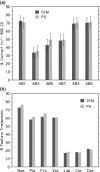Evaluation of a cochlear-implant processing strategy incorporating phantom stimulation and asymmetric pulses
- PMID: 25358027
- PMCID: PMC4266076
- DOI: 10.3109/14992027.2014.932024
Evaluation of a cochlear-implant processing strategy incorporating phantom stimulation and asymmetric pulses
Abstract
Objective: To evaluate a speech-processing strategy in which the lowest frequency channel is conveyed using an asymmetric pulse shape and "phantom stimulation", where current is injected into one intra-cochlear electrode and where the return current is shared between an intra-cochlear and an extra-cochlear electrode. This strategy is expected to provide more selective excitation of the cochlear apex, compared to a standard strategy where the lowest-frequency channel is conveyed by symmetric pulses in monopolar mode. In both strategies all other channels were conveyed by monopolar stimulation.
Design: Within-subjects comparison between the two strategies. Four experiments: (1) discrimination between the strategies, controlling for loudness differences, (2) consonant identification, (3) recognition of lowpass-filtered sentences in quiet, (4) sentence recognition in the presence of a competing speaker.
Study sample: Eight users of the Advanced Bionics CII/Hi-Res 90k cochlear implant.
Results: Listeners could easily discriminate between the two strategies but no consistent differences in performance were observed.
Conclusions: The proposed method does not improve speech perception, at least in the short term.
Keywords: Cochlear implants; asymmetric pulses; phantom stimulation; speech perception.
Figures





References
-
- Carlyon R.P., Deeks J.M., McKay C.M. The upper limit of temporal pitch: Stimulus duration, conditioner pulses, and the number of electrodes stimulated. J Acoust Soc Am. 2010;127:1469–1478. - PubMed
-
- Carlyon R.P., Deeks J.M., Macherey O. Polarity effects on place pitch and loudness for three cochlear-implant designs and at different cochlear sites. J Acoust Soc Am. 2013;134:503–509. - PubMed
-
- Davis M.H., Johnsrude I.S., Hervais-Adelman A., Taylor K., McGettigan C. Lexical information drives; Perceptual learning of distorted speech: Evidence from the comprehension of noise-vocoded sentences. J Exp Psychol Gen. 2005;134:222–241. - PubMed
-
- Fu Q.J., Shannon R.V., Galvin J.J., III Perceptual learning following changes in the frequency-to-electrode assignment with the Nucleus-22 cochlear implant. J Acoust Soc Am. 2002;112:1664–1674. - PubMed
-
- Henshall K., McKay C.M. Frequency-to-electrode allocation and speech perception with cochlear implants. J Acoust Soc Am. 2002;111:1036–1044. - PubMed
Publication types
MeSH terms
Grants and funding
LinkOut - more resources
Full Text Sources
Other Literature Sources
Miscellaneous
